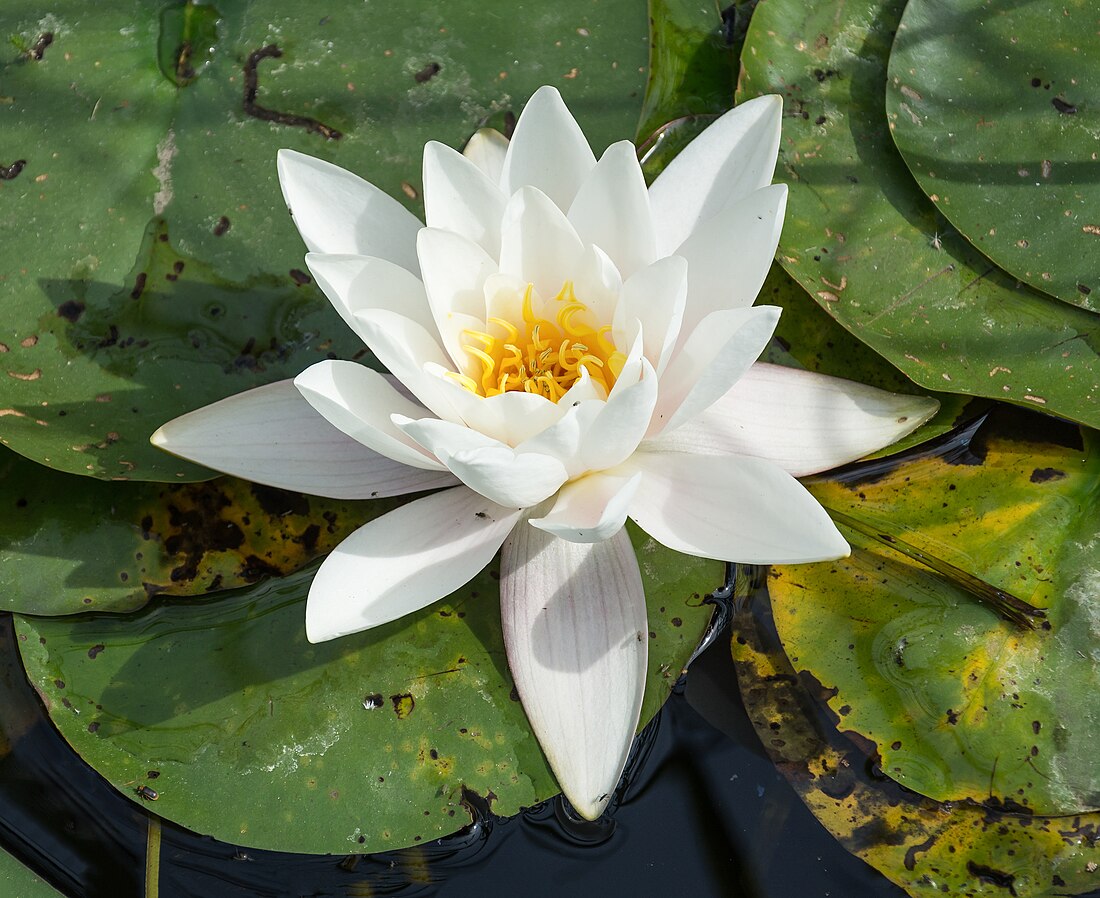Top Qs
Timeline
Chat
Perspective
Nymphaea alba
Species of water lily From Wikipedia, the free encyclopedia
Remove ads
Nymphaea alba – commonly called the white water lily, European white water lily, or white nenuphar (/ˈnɛnjʊˌfɑːr/) – is an aquatic flowering plant in the family Nymphaeaceae.[5][6][7] It is native to North Africa, temperate Asia, Europe, and tropical Asia (Jammu and Kashmir).[8]
Since Nymphaceae alba is an aquatic plant, its specialized trichomes are hydropotes, formed at an abaxial surface of the young leaf and packed tightly in the rosette at the rhizome's flattened apex. The rhizomes contain high amounts of carbohydrate and protein.[9]
Remove ads
Description
Nymphaea alba has a white flower that usually blooms during the daytime in most summer. The flower blooms on top of a big rounded green leaf up to 30 cm: both leaves float on the water's surface. At first, the flower bloom is cup-shaped, with a size of around 8 cm, then it rises to 20 cm and becomes star-shaped over time. The flower's petals are arranged in a row, pointing up surrounding several yellow stamens.[10][11] The leaves can be up to 30 cm (12 in) in diameter and take up a spread of 150 cm (59 in) per plant.[7]
Remove ads
Cytology
The chromosome count is n = 42. The genome size is 1950 Mb.[12]
Taxonomy
It was first published and described by Carl Linnaeus in his book 'Species Plantarum', on page 510 in 1753.[8][13] It is the type species of its genus.[14] Within the subgenus Nymphaea subg. Nymphaea it is placed in the section Nymphaea sect. Nymphaea.[8]
The red variety (Nymphaea alba f. rosea) is cultivated from lake Fagertärn ("Fair tarn") in the forest of Tiveden, Sweden, where it was discovered in the early 19th century. The discovery led to large-scale exploitation which nearly made it extinct in the wild before it was protected.[15]
Nymphaea candida J. Presl is sometimes considered a subspecies of N. alba (N. alba L. subsp. candida (J. Presl) Korsh.).[11]
Distribution and habitat
Summarize
Perspective
Nymphaea alba is native all over Europe and in parts of North Africa and the Middle East in fresh water.[2][11] In Africa, it is found in Algeria, Morocco and Tunisia. In temperate Asia, Armenia, Azerbaijan, Siberia, Iran, Iraq, Palestine and Turkey. It is found in tropical Asia, within the Indian territory of Jammu and Kashmir. Lastly, within Europe, it is found in Belarus, Estonia, Latvia, Lithuania, Moldova, Russian Federation, Ukraine, Austria, Belgium, Czech Republic, Germany, Hungary, Netherlands, Poland, Slovakia, Switzerland, Denmark, Finland, Ireland, Norway, Sweden, United Kingdom, Albania, Bosnia and Herzegovina, Bulgaria, Croatia, Greece, Italy, Montenegro, North Macedonia, Romania, Serbia, Slovenia, France, Portugal and Spain.[8] It has been introduced to the Azores, Bangladesh, Chile, parts of China, Myanmar, and New Zealand.[2]
Nymphaceae alba grows in ponds, ditches, lakes, or canals because these places have still and very slow-moving water. For example, lakes and ponds were created by gravel extraction as fishponds or for livestock, and lakes are just temporary features filled with sediment under and developing fen vegetation. Moreover, canals and ditches are more common than ponds since these are artificial water bodies created for transport or recreation; these places can support wildlife, such as attracting other species of insects or providing a shelter for frogs and early nectar insects.[16]
Remove ads
Phytochemistry
It contains the active alkaloids nupharine and nymphaeine, and is a sedative and an aphrodisiac/anaphrodisiac depending on sources.[citation needed] Although roots and stalks are used in traditional herbal medicine along with the flower, the petals and other flower parts are the most potent. Alcohol can be used to extract the active alkaloids, and it also boosts the sedative effects. The root of the plant was used by monks and nuns for hundreds of years as an anaphrodisiac, being crushed and mixed with wine. In the earliest printed medical textbooks, authors maintained this use, though warning against consuming large and frequent doses.[17]
Remove ads
Cultivation
Nymphaea alba needs plenty of space since it grows up to 4 in tall and 3 to 5 ft wide. This plant performs best under full sun in loamy soil and undisturbed water. The basket covers the plant with a pea shingle placed under the water's surface around 6 to 10 inches, and the lower part of the plant can be twice the initial planting depth when the plant is formed. This plant can be fed during the growing season by proprietary aquatic fertilizer.[18]
Water Lilly is valuable and nutritious when people can use the peduncle and young leaf for vegetables, and rhizomes can be used as food supplements; moreover, local people can use different parts of the plant for various purposes, such as making herbal medicine to treat diarrhea, piles or cough, or using as a fragrance and ornamental properties. Therefore, Nymphaceae alba (water lily) is collected in the wild and displayed in the market.[19]
- red cultivar
Remove ads
References
Wikiwand - on
Seamless Wikipedia browsing. On steroids.
Remove ads





